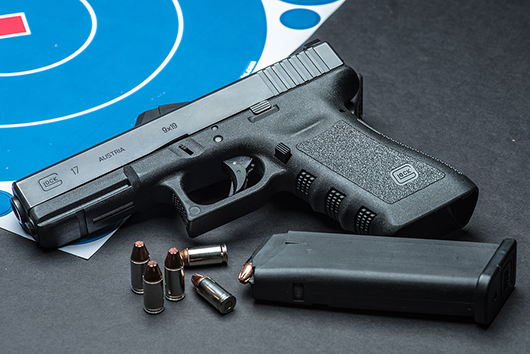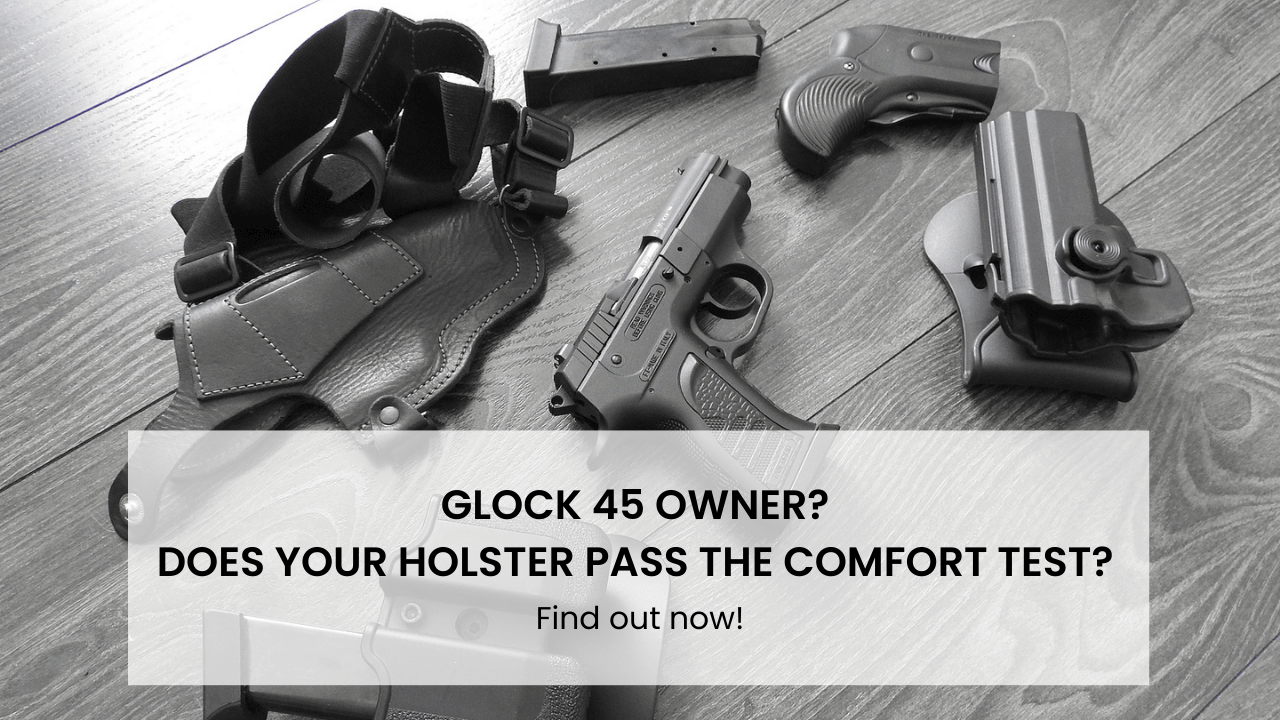How to Find the Perfect Gun Holster for Your Glock 19
May 11th 2021

If you’ve recently bought a Glock 19 for concealed or open carry, you’ll need a suitable gun holster. Finding the perfect holster requires a discussion of essential holster criteria, concealment elements, carry positions, and materials.
Glock 19
Who isn’t familiar with the Glock? The iconic polymer-framed, striker-fired semi-automatic pistol with the rectangular slide. While not the first polymer-framed or striker-fired pistol, the Glock was nevertheless ahead of its time.
It was rugged, reliable, reasonably accurate, lightweight, and relatively inexpensive. The Glock was famously adopted by the Austrian Army in 1982, outclassing several established competitors. In 1986, Glock began manufacturing this latest addition to the wave of “wonder nines” in the United States (Georgia).
In 1988, the firm introduced the first of many compact variants — the Glock 19 chambered in 9mm Luger. Featuring a 4.02” barrel, the G19 is shorter in overall length (7.28” vs. 8.03”) and height (5.04” vs. 5.47”) than its full-size predecessor — the Glock 17. It’s also more than two oz. lighter — weight with a loaded magazine is only 30.16 oz.
Concealment
When you’re trying to conceal a handgun, the height from the top of the slide to the bottom of the magazine affects concealment more than the overall length. You can choose to conceal your handgun more deeply to compensate for a longer barrel and slide. However, when you’re carrying a Glock in a holster on your hip, the protrusion of the butt outward can cause noticeable printing. This is why the compact Glock 19 prints less than the full-size G17, and the subcompact G26 prints less than the G19.
Whether you experience printing is a point of concern among those who carry concealed firearms. Printing occurs when your gun displays a visible outline through clothing, disclosing its existence by shape.
Your choice of holster and gun belt can reduce printinggun h by keeping your weapon close to your body. The guns that you carry and your choice of clothing are also factors that increase or decrease printing.
If you can, wear multiple layers of clothing. This may not be practical during the summer months, but during autumn and winter, it can help considerably.
Furthermore, be careful when bending over. This can accentuate the pistol, drawing attention to your weapon. If you need to reach for something on the ground, crouch.
How to Find the Perfect Holster
When you’re in the market to buy a holster, you can’t cut corners. A high-quality holster is an essential accessory for any handgun you intend to carry for the purpose of self-defense. Your weapon is reliable and rugged — your holster should be too.
You should be aware of two abbreviations regarding waistband holsters: IWB (inside the waistband) and OWB (outside the waistband).
IWB holsters are ideal for deep concealment. Your clothing conceals more of the holster by having the holster ride on the inside of the waistband against your body.
Depending on the holster, IWB carry allows you to tuck your T-shirt or collared shirt over the holster and into your pants. To draw from a tuckable holster, you’ll need to grip your shirt and pull upward forcefully. An IWB holster may require that you wear a waistband size up to accommodate the increased bulk.
You should experiment with a variety of holster designs to determine which is the most comfortable and offers the perfect fit.
OWB holsters are ideal for open carry and concealed carry when wearing a cover garment. As the holster rides on the outside of the waistband, OWB is less concealable. However, it’s also generally more comfortable.
Holster Retention
Retention is the ability of the holster to hold your gun securely, preventing it from falling out or being taken without your consent. If you want to test the retention of your holster, you can turn the holster upside down.
Whether you’re carrying openly or concealed, you may want a holster with active or passive retention. Active denotes the need to unlock the handgun from the holster to complete the draw stroke. This usually means using your thumb or index finger to depress a button, rotate a lever, or open a snap closure. Passive means that the friction between the holster and the gun is all that stops it from falling out or being drawn.
For open carry, active retention is more secure — it can delay an attempted disarm long enough for you to respond accordingly. Active retention is also beneficial or necessary in holster designs that either can’t retain the weapon any other way or are particularly prone to wear. However, active systems also complicate your draw stroke, costing valuable time.
For concealed carry, passive retention is optimal, allowing for a simpler and more rapid draw.
Find a holster that provides adjustable retention. By loosening or tightening one or two screws, you should be able to increase or decrease the force you need to apply to break the gun free.
Ride Height and Cant
The ride height is how deeply your holster sits in relation to the beltline. The cant is the degree to which the butt of the pistol is tilted up or down relative to the beltline. A forward cant exposes more of the butt, raising it upward. A reverse cant lowers the butt, reducing the clearance between the gun belt and the pistol grip.
You should adjust the ride height and cant until you find the perfect combination. These factors directly affect concealability — including whether the pistol prints — and your ability to access and draw it.
Holster Safety
When you acquire a full firing grip — i.e., place your hand firmly on the pistol grip — your index finger should remain straight until your sights are on the target or you’re pointing the muzzle toward the threat.
Under stress, several physiological phenomena can cause you to unintentionally press the trigger, such as the startle reflex. Gun owners should always practice consistent trigger discipline — Rule #3: “Keep your finger off the trigger until your sights are on the target” — to minimize this risk.
While trigger discipline is your responsibility as a gun owner, the holster you choose should not hinder your efforts. The holster should cover the trigger guard, preventing your finger from interacting with the trigger until the pistol clears the holster.
Furthermore, whatever holster you choose, its mouth — the opening into which you insert your firearm — should remain open when empty. If you draw your pistol and the mouth collapses, you’ll have to reopen it with your non-dominant hand during the re-holstering process. That may cause you to inadvertently cover your support hand with the muzzle.
Sweat Shield/Guard
Don’t underestimate the importance of comfort when searching for a concealed-carry holster. If your holster is uncomfortable when pressed against your skin, you need to place a layer of clothing or padding between the two. One of the design features you should consider is a sweat shield or guard.
A sweat shield is part of the holster covering the slide, preventing it from contact with you or your clothing. While a sweat shield’s primary purpose is to protect the gun’s finish against the corrosive effects of perspiration, it can also prevent you from contacting a hot slide after a prolonged shooting session.
Kydex Holsters
Although leather is still a prevalent choice for gun holsters, you need a material that lives up to the standard set by Glock. Kydex is a durable thermoplastic that holster and sheath manufacturers can form to the exterior contours of a pistol’s slide and frame, producing a custom-molded holster.
The custom-molding process is critical to the holster’s ability to adhere to the firearm, delivering a high degree of retention. When you insert the pistol into the holster, you will hear an audible click.
Popular Waistband Positions
Of the numerous waistband carry positions, the two most popular are strong side and appendix. In strong-side carry, you place your holster on your dominant or strong side. If you’re a right-handed shooter, your holster would be on your right side.
Some shooters find that placing the holster directly over the right hip at the 3 o’clock position causes discomfort. If this is your experience, consider placing the holster behind the hip at the 4 or 5 o’clock position. The latter is called “kidney carry” and can solve this problem immediately.
In appendix carry, you place the holster behind your belt buckle and to the right of your navel. Appendix carry points the muzzle of your gun toward your groin and femoral artery.
In addition, the Glock series does not have a manual safety catch, relying on a passive trigger safety. As a result, when carrying Glock guns in this manner, it is especially critical that you practice trigger discipline when drawing from this position. The risk of death or serious bodily injury is higher.
A Word on Reholstering
Drawing and reholstering your firearm is a dangerous activity that requires vigilance. There’s also no practical need to reholster your firearm rapidly. This invites disaster. If loose holster material, clothing, or debris enters the holster without your knowledge, a forceful downward stroke can activate the trigger.
Reholster your firearm slowly and carefully. If you respond to and incapacitate a threat in real-world defensive shooting, you should only return your weapon to its holster when the danger has dissipated. If you’re still in danger, your weapon should be in your hand.
Alternatives to the Waistband Holster
While IWB and belt holsters are popular for concealed carry, they’re not available to everyone. Depending on your circumstances, you may need to use a non-waistband holster.
The shoulder holster uses a four-point harness and allows you to carry your Glock on the non-dominant side under your arm. Depending on the design, the muzzle may be facing rearward on the horizontal plane or downward. On your dominant or strong side is typically one or two magazine pouches. The classic designs use snap closures.
The advantage of the shoulder holster is that it’s comfortable to draw from when sitting.
The downsides are that it’s slow to draw from, can cause you to muzzle sweep bystanders, many firing ranges, and shooting schools prohibit it, and you usually need two hands to reholster your weapon.
There are also ankle holsters. For carrying a Glock 19, an ankle holster may not be suitable. If you want to carry a subcompact Glock, such as the 10-round G26 or 6-round G42/43, as a backup gun, an ankle holster can be beneficial.
Practice Makes Perfect

Before settling on a gun holster, you should experiment with a variety of different methods and positions — waistband, IWB and OWB, appendix, strong side, etc. — to see which you find the most comfortable.
Once you’ve narrowed your selection, practice with it. Wear your holster on a firing range the way you would daily.
Practicing drawing from several positions under different conditions. Practice when seated in your vehicle, lying prone, kneeling, and from behind cover. Don’t wait until you need to draw your weapon in self-defense to determine how practical your methods are.
In Sum
To gain the most from carrying your Glock 19, you should find a suitable holster. At Incognito Concealment, we offer a range of high-quality, durable Kydex holsters to fit any Glock semi-automatic pistol. If you need to find the perfect holster for your Glock, give us a call at (586) 999-5820.











